Royal Indian Navy
| Royal Indian Navy | |
|---|---|
 | |
| Active | 5 September 1612 – 26 January 1950[1] |
| Country | India |
| Type | Navy |
| Size | 20,000 personnel During WW2 (1943)[2]to 9,600 personnel by Independence after post war demobilization (1947)[3][4] |
| Garrison/HQ | Bombay |
| Nickname(s) | RIN |
| Engagements | Seven Years' War American War of Independence Napoleonic Wars Anglo-Burmese Wars First Opium War Second Opium War First World War Second World War |
| Insignia | |
| Naval Ensign (1879-1928) & Naval Jack (1928-1947) |  |
| Naval Ensign (1928-1950) | 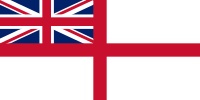 |
TheRoyal Indian Navy(RIN) was the naval force ofBritish Indiaand theDominion of India.Along with thePresidency armies,later theIndian Army,and from 1932 theRoyal Indian Air Force,it was one of the Armed Forces of British India.
From its origins in 1612 as theEast India Company's Marine,the Navy underwent various changes, including changes to its name. Over time it was named theBombay Marine(1686), theBombay Marine Corps(1829), theIndian Navy(1830),Her Majesty's Indian Navy(1858), theBombay and Bengal Marine(1863), theIndian Defence Force(1871),Her Majesty's Indian Marine(1877) and theRoyal Indian Marine(1892). It was finally named theRoyal Indian Navyin 1934. However, it remained a relatively small force until theSecond World War,when it was greatly expanded.
After thepartition of Indiainto two independent states in 1947, the Navy was split between Pakistan and India. One-third of the assets and personnel were assigned to theRoyal Pakistan Navy.Approximately two thirds of the fleet remained with the Union of India, as did all land assets within its territory. This force, still under the name of "Royal Indian Navy", became the navy of the Dominion of India until the country became a republic on 26 January 1950. It was then renamed theIndian Navy.
History[edit]


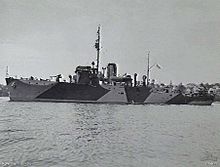


East India Company[edit]
1612–1830, the Bombay Marine[edit]
TheEast India Companywas established in 1599, and it began to create a fleet of fighting ships in 1612, soon after CaptainThomas Bestdefeated thePortugueseat theBattle of Swally.This led the company to build a port and to establish a small navy based atSuvali,inSurat,Gujarat,to protect its trade routes. The Company named the force the 'Honourable East India Company's Marine', and the first fighting ships arrived on 5 September 1612.[5]
This force protectedmerchant shippingoff theGulf of Cambayand the riversTaptiandNarmada.The ships also helped map the coastlines of India, Persia and Arabia.[6]During the 17th century, the small naval fleet consisted of a few English warships and a large number of locally built gunboats of two types,ghurabsandgallivats,crewed by local fishermen. The largerghurabswere heavy, shallow-draftgunboatsof 300 tons (bm) each, and carried six 9 to 12-pounder guns; the smallergallivatswere about 70 tons (bm) each and carried six 2 to 4-pounder guns.[7]In 1635, the East India Company established ashipyardatSurat,where they built fourpinnacesand a few larger vessels to supplement their fleet.[8]
In 1686, with most of the English commerce moving toBombay,the force was renamed the "Bombay Marine".[5]This force fought theMarathasand the Sidis and took part in theAnglo-Burmese Wars.While it recruited Indian sailors extensively, it had no Indian commissioned officers.[6]
Commodore William Jameswas appointed to command the Marine in 1751. On 2 April 1755, commanding the Bombay Marine's shipProtector,he attacked theMarathafortress of Tulaji Angre atSeverndroogbetweenBombayandGoa.James had instructions only to blockade the stronghold, but he was able to get close enough to bombard and destroy it.[6]
In February 1756, the Marine supported the capture of Gheriah (Vijaydurg Fort) byRobert Cliveand Admiral Watson, and was active in skirmishes against the French, helping to consolidate the British position in India.[6]In 1809, a fleet of 12 ships of the Marine bombarded the city ofRas al-Khaimah,a pirate stronghold, in an unsuccessful attempt to quell Arab piracy. A subsequent mission in 1819 with 11 vessels proved successful in blockading the city for four days, after which the tribal chieftain surrendered.
In 1829, the "Bombay Marine" received the additional name of "Corps", and also received its first steam-powered vessel,HCSHugh Lindsay.Steaming from Bombay on 20 March 1830,Hugh LindsayreachedSuezafter 21 days under steam (plus coaling stops atAden,Mocha,andJeddah), at an average speed of six knots.[9]Between 1830 and 1854 the Indian Navy was responsible for maintaining mail service on the Bombay and Suez leg of the "overland route" (England–Alexandria, Alexandria–Suez overland, and Suez–Bombay).
1830–1858[edit]
In 1830, the Bombay Marine was renamed the "Indian Navy". The British capture ofAdenin theAden Expeditionincreased its commitments, leading to the creation of the "Indus Flotilla". The Navy then took part in theFirst Opium Warof 1840.[6]By 1845, the Indian Navy had completed the conversion from sail to steam.[9]
In 1848, an Indian Navy contingent of 100 ratings and seven officers took part in theSiege of Multanduring theAnglo-Sikh War.[10]In 1852, at the outset of theSecond Anglo-Burmese War,ships of Her Majesty's Indian Navy joined aRoyal Navyforce under the command ofAdmiral Charles Austento assistGeneral Godwinin the capture ofMartabanandRangoon.[11]
Direct British rule in India[edit]
After the end ofCompany rule in Indiafollowing theIndian rebellion of 1857,the force came under the command of the British government of India and was formally named "Her Majesty's Indian Navy".[6]
1858–1934[edit]
Her Majesty's Indian Navy resumed the name "Bombay Marine" from 1863 to 1877, when it was renamed "Her Majesty's Indian Marine" (HMIM). The Marine then had two divisions; an Eastern Division atCalcuttaand a Western Division at Bombay.
| Indian Marine Service Act 1884 | |
|---|---|
| Act of Parliament | |
 | |
| Long title | An Act to provide for the regulation of Her Majesty's Indian Marine Service. |
| Citation | 47 & 48 Vict.c. 38 |
| Dates | |
| Royal assent | 28 July 1884 |
As the HMIM wasn't covered byNaval Discipline Act 1866(29 & 30 Vict.c. 109) or theMerchant Shipping Act 1854(17 & 18 Vict.c. 104), the Governor General in Council was empowered to by theIndian Marine Service Act 1884(47 & 48 Vict.c. 3)[12]to help formulate maritime and naval laws. These laws were first formulated and codified in the "Indian Marine Act, 1887[13]"and followed by an amendment act to the same in the next year.[14]The former adopted the general lines of the Naval Discipline and Indian Navy Acts as far as possible, whilst the latter merely supplied deficiencies in regard to grading and rating.[15]
In recognition of its fighting services, HMIM was given the title of "Royal Indian Marine" in 1892. By this time it consisted of over fifty vessels.[16]In 1905, the service was described as having "Government vessels engaged in troop-ship, surveying, police or revenue duties in the East Indies".[17]
When mines were detected off the coasts of Bombay and Aden, during theFirst World War,the Royal Indian Marine went into action with a fleet ofminesweepers,patrol vessels and troop carriers. Besides patrolling, the Marine ferried troops and carried war stores from India toMesopotamia(nowIraq),EgyptandEast Africa.
The first Indian to be granted a commission was Engineer Sub-Lieutenant D.N. Mukherji, who joined the Royal Indian Marine as an officer on 6 January 1923.[18]
World War II[edit]
In 1934, the Royal Indian Marine changed its name, with the enactment of the Indian Navy (Discipline) Act 1934. The Royal Indian Navy was formally inaugurated on 2 October 1934, at Bombay.[19]Its ships carried the prefixHMIS,for His Majesty's Indian Ship.[20]
At the start of theSecond World War,the Royal Indian Navy was small, with only eight warships. The onset of the war led to an expansion in vessels and personnel described by one writer as "phenomenal". By 1943 the strength of the RIN had reached twenty thousand.[2]During the war, theWomen's Royal Indian Naval Servicewas established, for the first time giving women a role in the navy, although they did not serve on board its ships.[19]
During the course of the war, six anti-aircraftsloopsand several fleet minesweepers were built in the United Kingdom for the RIN. After commissioning, many of these ships joined various escort groups operating in the northern approaches to the British Isles.HMISSutlejandHMISJumna,each armed with six high-angle 4-inch guns, were present during the Clyde "Blitz" of 1941 and assisted the defence of this area by providing anti-aircraft cover. For the next six months these two ships joined the Clyde Escort Force, operating in the Atlantic and later the Irish Sea Escort Force where they acted as the senior ships of the groups. While engaged on these duties, numerous attacks against U-boats were carried out and attacks by hostile aircraft repelled. At the time of action in which theGerman battleshipBismarckwas involved, theSutlejleft Scapa Flow, with all despatch as the senior member of a group, to take over a convoy from the destroyers which were finally engaged in the sinking of theBismarck.[21]
LaterHMISCauvery,HMISKistna,HMISNarbada,HMISGodavari,also anti-aircraft sloops, completed similar periods in the U.K. waters escorting convoys in the Atlantic and dealing with attacks from hostile U-boats, aircraft and glider bombs. These six ships and the minesweepers all eventually proceeded to India carrying out various duties in the North Atlantic, Mediterranean and Cape stations en route. The fleet minesweepers wereHMISKathiawar,HMISKumaon,HMISBaluchistan,HMISCarnatic,HMISKhyber,HMISKonkan,HMISOrissa,HMISRajputana,HMISRohilkhand.[21]
HMISBengalwas a part of theEastern Fleetduring World War II, and escorted numerous convoys between 1942 and 1945.[22]
The sloopsHMISSutlejandHMISJumnaplayed a role inOperation Husky,the Allied invasion ofSicilyby providing air defence and anti-submarine screening to the invasion fleet.[23][24]
Furthermore, the Royal Indian Navy participated in convoy escort duties in the Indian Ocean and Mediterranean and was heavily involved in combat operations as part of theBurma Campaign,carrying out raids, shore bombardment, naval invasion support and other activities.[25]
[edit]
The sloopHMISPathanwas sunk in June 1940 by the Italian Navy SubmarineGalvaniduring theEast African Campaign[26][27][28][29]
In the days immediately following theAttack on Pearl Harbor,HMSGlasgowwas patrolling theLaccadive Islandsin search of Japanese ships and submarines. At midnight on 9 December 1941, HMSGlasgowsank the RIN patrol vesselHMISPrabhavatiwith twolightersin tow en route to Karachi, with 6-inch shells at 6,000 yards (5,500 m).Prabhavatiwas alongside the lighters and was mistaken for a surfaced Japanese submarine.[30][31][32]
HMISInduswas sunk by a Japanese aircraft during the Burma Campaign on 6 April 1942.[33]
[edit]
HMISJumnawas ordered in 1939, and built byWilliam Denny and Brothers.She wascommissionedin 1941,[34]and with World War II underway, was immediately deployed as a convoy escort.Jumnaserved as an anti-aircraft escort during theJava Sea campaignin early 1942, and was involved in intensive anti-aircraft action against attacking Japanese twin-engined level bombers and dive bombers, claiming five aircraft downed from 24 to 28 February 1942.
In June 1942,HMISBombaywas involved in the defence of Sydney Harbour during theattack on Sydney Harbour.
On 11 November 1942,Bengalwas escorting the Dutch tankerOndina[35]to the southwest ofCocos Islandsin the Indian Ocean. Two Japanesecommerce raidersarmed with six-inch guns attackedOndina.Bengalfired her single four-inch gun andOndinafired her 102 mm and both scored hits onHōkoku Maru,which shortly blew up and sank.[35][36]
On 12 February 1944, theJapanese submarineRo-110was depth charged and sunk east-south-east off Visakhapatnam, India by the Indian sloopHMISJumnaand the Australian corvettesHMASLauncestonandHMASIpswich.Ro-110had attacked convoy JC-36 (Colombo-Calcutta) and torpedoed and damaged the British merchantAsphalion(6,274 GRT).[34][37]
On 12 August 1944, theGerman submarineU-198was sunk near theSeychelles,in position 03º35'S, 52º49'E, bydepth chargesfromHMISGodavariand the British frigateHMSFindhorn.[38][33]
Mutiny of 1946[edit]
In February 1946, Indian sailors launched theRoyal Indian Navy Mutinyon board more than fifty ships and in shore establishments, protesting about issues such as the slow rate of demobilization and discrimination in the Navy.[39]The mutiny found widespread support and spread all over India, including elements in theArmyand theAir Force.A total of seventy-eight ships, twenty shore establishments and 20,000 sailors were involved in this mutiny.
Transition to Independence and Partition[edit]
On 1 March 1947, the designation of "Flag Officer Commanding, Royal Indian Navy" was replaced with that of "Commander-in-Chief, Royal Indian Navy."[40]On 21 July 1947, H.M.S. Choudhry and Bhaskar Sadashiv Soman, both of whom later commanded the Pakistani and Indian Navies, respectively, became the first Indian RIN officers to attain the acting rank of captain.[41]Following India's independence in 1947 and the ensuing partition, the Royal Indian Navy was divided between the newly independentDominion of Indiaand theDominion of Pakistan,and the Armed Forces Reconstitution Committee divided the ships and men of the Royal Indian Navy between India and Pakistan. The division of the ships was on the basis of two-thirds of the fleet to India, one third to Pakistan.[42]
The committee allocated to theRoyal Pakistan Navy(RPN) three of the seven active sloops,HMISGodavari,HMISHindustanandHMISNarbada,four of the ten serviceableminesweepers,twofrigates,twonaval trawlers,four harbour launches and a number ofHarbour Defence Motor Launches.358 personnel, and 180 officers, most of whom were Muslims or Europeans, volunteered to transfer to the RPN. India retained the remainder of the RIN's assets and personnel, and many British officers opted to continue serving in the RIN.[19]As only nine of the Navy's 620 Indian commissioned officers in 1947 had more than 10 years' service, with the majority of them only having served from five to eight years, British officers seconded from the Royal Navy continued to hold senior RIN shore appointments after Independence, though all naval vessels had Indian commanders by the year's end.[43]
Dominion of India[edit]
In May 1948,Ajitendu Chakravertibecame the first Indian commodore in the post-independence RIN, in the appointment of Chief of Staff Naval HQ.[44]On 21 June 1948, the additional designation of "Chief of the Naval Staff" was added before that of "Commander-in-Chief, Royal Indian Navy."[45]In January 1949, the first batch of 13 Indian officers began their flight training, initiating the process which would lead to the formation of theIndian Naval Air Arm.[46]
On 26 January 1950, when India adopted its currentconstitutionand became arepublic,the Royal Indian Navy became theIndian Navy.Its vessels were redesignated as "Indian Naval Ships", and the "HMIS" ship prefix for existing vessels was changed to 'INS'.[47]At 9:00 that morning, theWhite Ensignof the Royal Navy was struck and replaced with theIndian Naval Ensign,with theFlag of Indiain its canton, symbolically completing the transition to the new Indian Navy.[48]
Commanding officers[edit]
| S.No | Portrait | Name | Assumed office | Left office | Time in office | Ref | |
|---|---|---|---|---|---|---|---|
| Commodore, Bombay Marine (1738-1739) | |||||||
| 1 | Commodore Bagwell | 1739 | 1739 | 1 year | [49] | ||
| Superintendent, Bombay Marine (1739-1830) | |||||||
| 1 | Charles Rigby Esq. (also Deputy Governor of Bombay) |
1739 | [49] | ||||
| 2 | 
|
CommodoreSir William James, 1st Baronet | 1751 | 1754 | 3 years | [49] | |
| 3 | Captain Samuel Hough | 1754 | 1772 | 18 years | [49] | ||
| 4 | Commodore John Watson | 1772 | 1774 | 2 years | [49] | ||
| 5 | Captain Simon Matham | 1774 | 1776 | 2 years | [49] | ||
| 6 | CommodoreGeorge Emptage | 1781 | 1785 | 4 years | [49] | ||
| 7 | CaptainPhilip Dundas | 1792 | 1801 | 9 years | [50] | ||
| 8 | 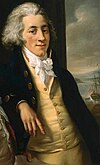
|
Captain SirWilliam Taylor Money | 1801 | 1810 | 9 years | [51] | |
| 9 | CaptainHenry Meriton | 1813 | 1825 | 12 years | [49][52] | ||
| 10 | Captain Thomas Buchanan | 1825 | 1827 | 2 years | [49][53] | ||
| 11 | 
|
CaptainSir Charles MalcolmCB | 1827 | 1830 | 3 years | [54][49][55] | |
| Superintendent, Indian Navy (1830-1844) | |||||||
| 1 | 
|
CaptainSir Charles MalcolmCB | April 1830 | 10 January 1837 | 6 years, 284 days | [49] | |
| 2 | Rear-AdmiralSir Charles MalcolmCB | 10 January 1837 | July 1838 | 1 year, 172 days | [49] | ||
| 3 | Captain Sir Robert Oliver | July 1838 | October 1844 | 6 years, 83 days | [49] | ||
| Officiating Superintendent, Indian Navy (1844-1845) | |||||||
| 1 | Captain John Pepper | October 1844 | April 1845 | 182 days | [49] | ||
| 2 | Acting CaptainHenry Blosse Lynch | April 1845 | December 1845 | 244 days | [49] | ||
| Superintendent, Indian Navy (1845-1848) | |||||||
| 1 | Captain Sir Robert Oliver | December 1845 | April 1848 | 2 years, 122 days | [49] | ||
| Commander-in-Chief, Indian Navy (1848) | |||||||
| 1 | Commodore Sir Robert Oliver | April 1848 | 6 August 1848 | 127 days | [49] | ||
| Officiating Superintendent, Indian Navy (1848-1849) | |||||||
| 1 | Captain Henry Blosse Lynch | 6 August 1848 | 30 August 1848 | 24 days | [49] | ||
| Superintendent, Indian Navy (1848-1849) | |||||||
| 1 | Captain John Croft Hawkins | 31 August 1848 | 26 January 1849 | 148 days | [49] | ||
| Superintendent & Commander-in-Chief, Indian Navy (1849–62) | |||||||
| 1 | CommodoreStephen Lushington | 26 January 1849 | March 1852 | 3 years, 35 days | [49] | ||
| 2 | CommodoreHenry John Leeke | March 1852 | 15 April 1854 | 2 years, 45 days | [49] | ||
| 3 | Rear-AdmiralHenry John Leeke | 15 April 1854 | July 1857 | 3 years, 77 days | [49] | ||
| 4 | 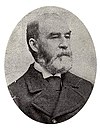
|
CommodoreGeorge Greville Wellesley | July 1857 | July 1862 | 5 years | [49] | |
| Superintendent, Indian Navy (1862-1863)) | |||||||
| 1 | Commodore John James Frushard | July 1862 | April 1863 | 274 days | [49] | ||
| Superintendent, Bombay Marine (1863-1874)) | |||||||
| 1 | Captain John Wellington YoungCB | April 1863 | April 1868 | 5 years | [49] | ||
| 2 | Captain G. F. Robinson | April 1868 | September 1874 | 6 years | [49] | ||
| Naval Adviser to Government of India (1874-1880) | |||||||
| 1 | 
|
CaptainJohn Bythesea | 5 August 1877 | November 1880 | 3 years | [49] | |
| 2 | Rear-AdmiralJohn Bythesea | 1874 | 5 August 1877 | 3 years | [49] | ||
| Director, Her Majesty's Indian Marine (1882–83) | |||||||
| 1 | Captain Harry Woodfall Brent | 1883 | 1883 | 1 year | [49] | ||
| Director of H.M.'s Indian Marine (1883–1892) | |||||||
| 1 | CaptainJohn Hext | 1883 | 1892 | 9 years | [49] | ||
| Director of the Royal Indian Marine (1892–1928)[n 1] | |||||||
| 1 | Rear-Admiral SirJohn HextKCIE (1842-1924) |
1892 | February 1898 | 6 years | |||
| 2 | Captain Walter Somerville GoodridgeCIE (30 March 1849-2 April 1929) |
5 March 1898 | 5 March 1904 | 6 years, 0 days | [56][57][58] | ||
| 3 | CaptainGeorge Hayley HewettCIE (30 November 1855-1930) |
5 March 1904 | 17 March 1909 | 5 years, 12 days | [59] | ||
| 4 | 
|
CommodoreWalter LumsdenCIE,CVO (16 April 1865-22 November 1947) |
17 March 1909 | 12 June 1917 | 8 years, 87 days | [60][61][62][63] | |
| 5 | Captain Neville Frederick Jarvis WilsonCMG,CBE (1865-1947) |
12 June 1917 | 27 August 1920 | 3 years, 76 days | [61][64][63] | ||
| 6 | Rear-AdmiralHenry Lancelot MawbeyCB,CVO (16 June 1870-4 June 1933) |
28 August 1920 | 3 August 1922 | 1 year, 340 days | [65][66][67] | ||
| 7 | 
|
Captain SirEdward James HeadlamCSI,CMG,DSO (1 May 1873-14 July 1943) |
3 August 1922 | 4 October 1928 | 6 years, 62 days | [68][69] | |
| Flag Officer Commanding and Director, Royal Indian Marine (1928–1934) | |||||||
| 1 | 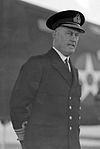
|
Vice-Admiral SirHumphrey T. WalwynKCSI,CB,DSO (1879-1957) |
5 October 1928 | 2 October 1934 | 5 years, 362 days | [69] | |
| Flag Officer Commanding, Royal Indian Navy (1934–1947) | |||||||
| 1 | 
|
Vice-Admiral SirHumphrey T. WalwynKCSI,CB,DSO (1879-1957) |
2 October 1934 | 16 November 1934 | 45 days | [70][71] | |
| 2 | 
|
Vice-AdmiralArthur BedfordCB,CSI (1881-1949) |
16 November 1934 | 23 November 1937 | 3 years, 7 days | [71][70][72][73] | |
| 3 | 
|
Vice-Admiral SirHerbert FitzherbertKCIE,CB,CMG (1885-1958) |
23 November 1937 | 19 March 1943 | 5 years, 119 days | [74][73] | |
| 4 | 
|
AdmiralJohn Henry GodfreyCB (1888-1970) |
19 March 1943 | 15 March 1946 | 2 years, 361 days | [70][75] | |
| 5 | Vice-Admiral SirGeoffrey Audley MilesKCB,KCSI (1890-1986) |
15 March 1946 | 1 March 1947 | 351 days | [74][40] | ||
| Commander-in-Chief, Royal Indian Navy (1947–1948) | |||||||
| 1 | Vice-Admiral SirGeoffrey Audley MilesKCB,KCSI (1890-1986) |
1 March 1947 | 14 August 1947 | 167 days | [74][40] | ||
| 2 | 
|
Rear AdmiralJohn Talbot Savignac HallCIE (1896-1964) |
15 August 1947 | 20 June 1948 | 310 days | [74][40] | |
| Chief of the Naval Staff and Commander-in-Chief, Royal Indian Navy (1948–1950) | |||||||
| 1 | 
|
Rear AdmiralJohn Talbot Savignac HallCIE (1896-1964) |
21 June 1948 | 14 August 1948 | 54 days | [74][45] | |
| 2 | Vice Admiral SirWilliam Edward ParryKCB (1893-1972) |
14 August 1948 | 25 January 1950 | 1 year, 164 days | |||
Partition of ships, 1947[edit]
| Vessel type | India | Pakistan |
|---|---|---|
| Frigate |
|
|
| Sloop | ||
| Corvettes | ||
| Minesweeper | ||
| Survey vessel |
|
|
| Trawler |
|
|
| Motor minesweeper(MMS) |
|
|
| Motor Launch(ML) |
|
- |
| Harbour Defence Motor Launch(HDML) |
|
|
| Tanker | ||
| Miscellaneous | All existing landing craft |
See also[edit]
- List of ships of the Royal Indian Navy
- List of ships of the Indian Navy
- Royal Indian Navy mutiny
- Indo-Pakistani relations
- History of the Indian Navy
- British Indian Army
- Royal Indian Air Force
Notes[edit]
References[edit]
- ^"Genesis of Indian Navy".Retrieved8 January2022.
- ^abMollo, Andrew (1976).Naval, Marine and Air Force uniforms of World War 2.Macmillan. p. 144.ISBN0-02-579391-8.
- ^Goldrick, James Vincent Purcell(1997)."The Pakistan Navy (1947-71)"(PDF).No Easy Answers: The development of the navies of India, Pakistan, Bangladesh, and Sri Lanka (1945-1996)(1st ed.). London, UK: Lancer Publishers. p. 270.ISBN9781897829-028.Retrieved29 January2019.
- ^According to Rear Admiral Goldrick, one-third of the Navy personnel went to join the Pakistan Navy, which was about ~3200 personnel, while overwhelmingly two-thirds of the personnel were retained in the Indian Navy after the partition. One-thirds of the ~9,600 is ~3,200.
- ^abHarbans Singh Bhatia,Military History of British India, 1607-1947(1977), p. 15
- ^abcdefCharles Rathbone Low,History of the Indian Navy: (1613-1863)(R. Bentley & Son, 1877)
- ^Rear Admiral Satyindra Singh AVSM,Under Two Ensigns: The Indian Navy 1945-1950(1986), p. 36
- ^Singh 1986, p. 40
- ^abRear Admiral Satyindra Singh AVSM,Under Two Ensigns: The Indian Navy 1945-1950(1986), p. 40-41
- ^Rear Admiral Satyindra Singh AVSM,Under Two Ensigns: The Indian Navy 1945-1950(1986), p. 42
- ^Edmund Burke, ed.,The Annual Register of the Year 1852(Longmans, Green, 1853),p. 283
- ^Piggott, Francis Taylor (1904).The Imperial Statutes Applicable to the Colonies.W. Clowes & sons, limited. p. 131.
- ^The Unrepealed General Acts of the Governor General in Council: 1895-90.Calcutta: Government printing press. 1898. p. 161.
- ^A Collection of the Acts of the Central Legislature and Ordinances of the Governor General.Calcutta: Manager of Publications. 1889. p. 84.
- ^Statement Exhibiting the Moral and Material Progress and Condition of India During the Year 1901-02.London. 1903. p. 297.
{{cite book}}:CS1 maint: location missing publisher (link) - ^Genesisat indiannavy.nic.inArchivedJanuary 11, 2011, at theWayback Machine
- ^Archibald Greig Cowie,The sea services of the empire as fields for employment(1905), p. 246
- ^D. J. E. Collins,The Royal Indian Navy, 1939-45,vol. 1 (Bombay, 1964), p. 8
- ^abcBhatia (1977), p. 28
- ^D. J. E. Collins,The Royal Indian Navy, 1939-45,vol. 1 (Bombay, 1964)
- ^abThe Royal Indian Navy, 1939–1945 - Collins, p248
- ^Kindell, Don."EASTERN FLEET - January to June 1943".ADMIRALTY WAR DIARIES of WORLD WAR 2.
- ^InmedArchived24 January 2008 at theWayback Machine
- ^The Royal Indian Navy, 1939–1945 - Collins, p252
- ^The Royal Indian Navy, 1939–1945 - Collins, p255 - p316
- ^Rohwer & Hummelchen, p.23
- ^Collins, D.J.E. (1964).The Royal Indian Navy, 1939–1945, Official History of the Indian Armed Forces In the Second World War.
{{cite book}}:|work=ignored (help) - ^"House of commons debate - Indian, Burman, and Colonial War Effort".House of Commons of the United Kingdom.20 November 1940.
- ^"Fighting the U-boats = Indian Naval forces".Uboat.net.
- ^"Allied Warships - HMIS Prabhavati".
- ^The Royal Indian Navy, 1939–1945 - Collins, p96
- ^Neil MacCart,Town Class Cruisers,Maritime Books, 2012,ISBN978-1-904-45952-1,p. 153
- ^abCollins, J.T.E. (1964).The Royal Indian Navy, 1939–1945.Official History of the Indian Armed Forces In the Second World War. New Delhi: Combined Inter-Services Historical Section (India & Pakistan).
- ^ab"HMIS Jumna (U 21)".uboat.net.Retrieved6 April2016.
- ^abVisser, Jan (1999–2000)."The Ondina Story".Forgotten Campaign: The Dutch East Indies Campaign 1941-1942.Archived fromthe originalon 21 March 2011.Retrieved4 May2021.
- ^L, Klemen (2000)."Forgotten Campaign: The Dutch East Indies Campaign 1941–1942".Archived fromthe originalon 26 July 2011.Retrieved4 May2021.
- ^The Royal Indian Navy, 1939–1945 - Collins, p309
- ^"HMIS Godavari (U 52) of the Royal Indian Navy - Indian Sloop of the Black Swan class - Allied Warships of WWII - uboat.net".
- ^Christopher M. Bell, Bruce A. Elleman,Naval mutinies of the twentieth century: an international perspective(2003), p. 6: "The first navy to experience a major mutiny after the Second World War was the Royal Indian Navy. For five days in February 1946, Indian sailors rose up against their predominantly British officer corps: approximately 56 ships..."
- ^abcd"Press Note"(PDF).Press Information Bureau of India - Archive.10 February 1947.Retrieved26 January2020.
- ^"Higher Ranks for Indian Officers of the R.I.N."(PDF).Press Information Bureau of India - Archive.21 July 1947.Retrieved3 January2021.
- ^Bhatia (1977), p. 28: "Consequent on the partition of the country on 15 August 1947, two thirds of the undivided fleet and associated assets came to India."
- ^"Nationalisation of Armed Forces"(PDF).Press Information Bureau of India - Archive.20 December 1947.Retrieved4 January2021.
- ^"PRESS INFORMATION BUREAU (DEFENcE WING)"(PDF).Press Information Bureau of India - Archive.8 May 1948.Retrieved3 January2021.
- ^ab"Press Communique"(PDF).Press Information Bureau of India - Archive.21 June 1948.Retrieved21 July2020.
- ^"RIN Takes to Aviation"(PDF).Press Information Bureau of India - Archive.24 January 1949.Retrieved3 January2021.
- ^Indian and Foreign Review,vol 3 (Indian Ministry of Information and Broadcasting Publications Division, 1965), p. 65: "The residual part which continued as the Royal Indian Navy had to face many problems, specially regarding personnel. On India becoming a republic on January 26, 1950, the Navy dropped the word" Royal "in its name and became the Indian Navy."
- ^"Indian Naval Ensign Replaces the White Ensign"(PDF).Press Information Bureau of India - Archive.19 January 1950.Retrieved16 February2020.
- ^abcdefghijklmnopqrstuvwxyzaaabacadaeSridharan. AVSM (Retd)., Rear-Admiral K. (1 January 1982). "Appendix I: Chief's of the Navy of India".A Maritime History of India.New Delhi, Republic of India.: Minister of Publications and Broadcasting, Government of India. pp. 415–418.ISBN9781135146788.
- ^Day, John Frederick. (April 2012) ' British Admiralty Control and Naval Power in the Indian Ocean (1793-1815) (Volume 1 of 2)'. Submitted as a thesis for the degree of Doctor of Philosophy in Maritime History, University of Exeter. p. 429.
- ^Day. p. 429.
- ^"Letter from William Bruce, Resident at Bushire to Henry Meriton, Superintendent of the HC Marine, Bombay (1822)".Qatar Digital Library.Doha: Qatar National Library. 26 November 2014.Retrieved14 June2021.
- ^"The Monthly Miscellany".The Asiatic Journal.25.London: Wm. H. Allen & Company: 120. 1822.
- ^Parliament, British (1876).Reports from Commissioners.House of Commons. p. 216.
- ^Laughton, John Knox (1885–1900).Dictionary of National Biography: Malcolm, Charles(Vol 35 ed.). London: Smith, Elder & Co. pp. 402–403.
- ^The London Gazette, 1 January 1901
- ^"Lot 596, Orders, Decorations, Medals and Militaria (30 March 2011) - Dix Noonan Webb".googleusercontent.com.[permanent dead link]
- ^Wadia, A. R. (1957).The Bombay Dockyard and the Wadia Master Builders.p. 86.
- ^"Officers of the Royal Indian Marine".The Navy List: July 1908.HM Government, UK. July 1908. p. 439.
- ^"Officers of the Royal Indian Marine".The Navy List: January 1918.HM Government, UK. January 1916. p. 489.
- ^ab"Officers of the Royal Indian Marine".The Navy List: January 1920.HM Government, UK. January 1920. p. 1158.
- ^Who's Who,1948, pp 1703-1704
- ^abAdministration Report: Bombay Port Trust 1916-17.Government of Bombay. 1917. p. 81.
- ^"Officers of the Royal Indian Marine".The Navy List: November 1920.HM Government, UK. November 1920. p. 1168.
- ^Sridharan, K.A Maritime History of India(2nd ed.). Publications Division, Ministry of Information and Broadcasting, Government of India.
- ^The London Gazette, 23 June 1922
- ^"Henry Lancelot Mawbey".dreadnoughtproject.org.
- ^"E-H. HEADLAM".headlam.me.uk.
- ^ab"The Royal Indian Marine".The Times.7 June 1928.
- ^abc"HyperWar: The Royal Indian Navy (Appendix 6)".ibiblio.org.
- ^ab"Royal Navy: Command of Indian Navy".The Times.16 November 1934.
- ^"RootsWeb: MARINERS-L Re: [Mar] Arthur E F Bedford".rootsweb.com.
- ^ab"The Royal Indian Navy".The Times.9 March 1937.
- ^abcde"World War II unit histories & officers".unithistories.com.Archived fromthe originalon 4 February 2012.Retrieved11 February2011.
- ^"Vice-Admiral Godfrey's New Post".The Times.19 March 1943.
Further reading[edit]
- Harbans Singh Bhatia,Military History of British India, 1607–1947(1977)
- Collins, D.J.E.The Royal Indian Navy(1964online official history
- Naval history of India
- Naval history of Pakistan
- Military units and formations established in 1934
- Military units and formations disestablished in 1950
- 1612 establishments in India
- 1612 establishments in the British Empire
- Military history of India during World War II
- India–Pakistan military relations
- Organisations based in India with royal patronage
